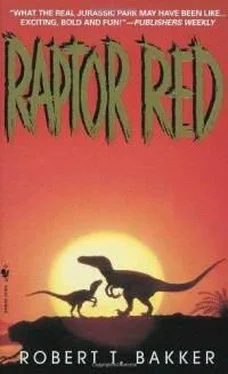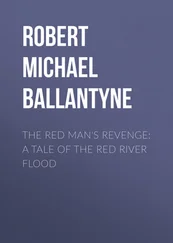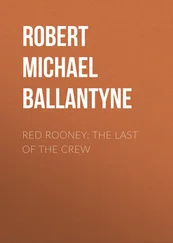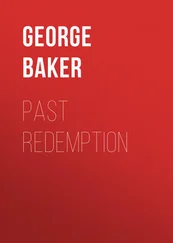FLOOD AND PANZERS!
EARLY JUNE
Raptor Red wakes up in the middle of the night. She often does - predators are light sleepers. Her pack-mates are sleeping on an abandoned croc-nest, heaped high with dried vegetation cemented with mud. It’s a comfortable lair, dry, with a view over the valley so the adults can keep track of the herbivore herds and the comings and goings of Yellow Snouts and giant acro predators.
The pack used the croc-nest as a base for a month after they were forced to leave Tick-Bird Meadow when the Acrocanthosaurus took control of the astrodon carcass.
Raptor Red stares to the west. A mixed herd of iguanodons and astros is making a terrific racket, bellowing, snorting, screaming. Iguanodons often join their social units to a pod of astros. Iguanodons have excellent eyesight, but their short necks and low shoulders make it hard for them to survey their surroundings and detect predators at a distance. Astros can see for miles when they raise their long necks twenty-five feet above ground level.
The astro sentries have been making it hard for the raptor pack to sneak up on the iguanodons in the last few days. And the huge, nervous masses of iguanodons, ready to charge or stampede at the slightest provocation, have been making it hard for the raptors to isolate single astros.
Raptor Red and her sister have still managed to keep the chicks fed. But it’s been hard work. Back at Tick-Bird Meadow, nearly every one of their attacks had ended with a kill. Now only one out of five attacks succeeds. And there’ve been two close calls. Raptor Red’s sister was cornered by thirty or forty angry cow iguanodons, advancing shoulder to shoulder. The iguanodons, their courage multiplied by their numbers, made a group decision to switch from flight to murderous defense. The sight of one of their sisters lying dead, ripped open by raptor claws, pushed their iguanodon minds to a fury of revenge.
Then Raptor Red’s sister made a serious mis-judgment: She screamed at the cow herd and stood her ground next to the kill. Raptor Red had already retreated. She is the more cautious of the pair, the one who always evaluates and reevaluates the balance of risk and reward. But her sister can be like a whirling dervish, convinced of her indestructibility, lashing her claws, snapping her teeth, attacking when she should withdraw.
This time her frenzied belligerence almost made her chicks orphans. The iguanodon herd split up and made two wide crescents that almost surrounded the raptor mother. She backed up into a gulley, but the upstream end of the gulley was steep and slippery.
Thirty iguanodon cows started advancing up the gulley, swinging their deadly thumb-spikes. Another fifty or sixty were closing in from the left and right.
Raptor Red saw that in a second or two her sister would be flattened by a hundred angry hindpaws and jabbed by the spikes on a hundred iguanodon hands.
Raptor Red made a loud mock-attack from behind. For a moment the iguanodons' unified spirit was distracted. Those nearest the raptor mother stopped and looked around. Raptor Red’s sister scrambled up the gulley wall and escaped by climbing into the thick branches of a conifer tree.
That was yesterday morning. In the afternoon the raptor sisters found a cow who had been crippled in a fall and was abandoned by the rest of the herd. Easy kill.
Now Raptor Red monitors the movement of the herbivore herd in the night. The moon is nearly full and casts a cold, ivory light on the scene. Now and then the cool light plays across a hundred iguanodon backs.
Flickers of angry orange light appear on the western horizon far away. Cobalt-blue clouds are illuminated from underneath. A dull rumble reaches Raptor Red’s ears.
Suddenly, the western sky is brightly illuminated by a jagged white streak. Raptor Red tenses herself, knowing that a loud noise will come in five seconds or so.
Crackkk! Raptor Red shudders involuntarily at the noise.
The iguanodon-astro herd is coming close, passing a quarter-mile to the north. That’s alarming. The herd is downwind - they should be able to smell the raptor lair. Raptor Red worries that the cows are coming to avenge the death of their colleague. But that’s never happened before. Iguanodons don’t hold grudges for long. When raptors make a kill, either the cows attack immediately, or they go away and seem to forget all about their recently deceased kin.
Raptor Red gets ready for action, for quick evacuation of her kin group. But the noisy herbivores just keep going eastward, paying not the slightest attention.
Raptor Red stares up at the moon. Then she stares down at the moon. The moon’s reflection on the ground is almost as bright as the moon itself. But the ground reflection shimmers and quakes, and ripples seem to pass through it.
Raptor Red becomes alert. This isn’t right. The moon shouldn’t reflect off dry mud. It reflects that way only in water.
Then she feels a cold current on her toes! She jerks herself up. The rippled moon reflection is rising up to the level of the croc-nest. Pieces of foliage float by, fast.
She backs up to the top of the mound, bumping into her sister, who jumps up and falls over her chicks, who squeak in alarm, scurry over themselves, and promptly roll off the mound and right into the water. Plop, plop, plop!
Raptor Red would laugh if evolution had given her a way to generate that sound. The chicks were particularly naughty yesterday, getting in the way of the adults in a very serious situation. Raptor Red wanted to swat them hard.
Her sister gets very excited and jumps in after the chicks, deluging them in splashes as she hops from one foot to another. Raptor Red calmly wades in, making hardly a ripple. Her sister is the better swimmer, but Raptor Red is better at wading and feeling her way through water in the dark.
A chick clambers up Raptor Red’s thigh and hangs on to her neck like a jockey. Another chick climbs the base of her tail and crawls, inchworm style, up to the first chick.
Raptor Red now has trouble balancing. The two chicks insist on shifting their weight first to one side, then the other. She sees the third chick, upside down, caught in a waterlogged cycad frond.
Raptor Red picks the chick up in her mouth.
Meanwhile, her sister is in panic mode, beating the water with her hands, trying to gather her chicks. She always was the high-strung one in her brood, given to fits of hysterical activity. Yet she raised three chicks to adult size last year and is doing quite well this year.
A huge turtle, a yard across, floats by.
Raptor Red is now worried. The water is coming faster and getting higher and she can’t go back to the summit of the croc-nest - it’ll be submerged in a few minutes. She has never experienced a life-or-death test in water. She doesn’t know what to do. She has no learned experience to help.
If she were able to fly up and over the storm flood and view the hills miles to the west, the way a white-winged dactyl is now doing, she would have been even more afraid. The dactyl has seen rain falling in the foothills for an entire day. He has seen rain clouds, heavy and gray, sitting on the western mountains for five days. The white dactyl has seen all this before, on three occasions during his long life. He’s aloft in the darkness now because he knows the floods are coming.
From three hundred feet above, he sees streams swollen beyond capacity. A billion tons of unrestrained water are escaping the confines of riverbanks.
Trees are being knocked down like twigs. Mud and sand, in volumes measured in cubic kilometers, are choking the waters.
Raptor Red’s family is experiencing a geological catastrophe, a disaster, a thousand-year flood.
When the climate cycle reaches a certain point of coincidence, when moist air from the Pacific mixes with moist air from the southern seas, and when temperatures are just right over the Nevada mountains, the thousand-year rains come. And Utah is flooded with muddy waters ten, twenty, and thirty feet thick. Mud blankets yards deep are left everywhere, burying living and dead dinosaurs. Crocodiles, fish, turtles, and tiny fur-bearing mammals too, are caught up in the mud torrents.
Читать дальше












